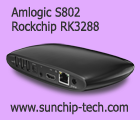Hanvon is the leading e-ink e-reader maker in the Chinese market with 70% market share, now they are also moving into making Android tablets. This one has a Samsung Hummingbird 1Ghz ARM Cortex-A8 processor, 512MB RAM, 7″ capacitive screen, and Hanvon has designed some custom home replacement user interface.
x86 vs ARM for Tablets, hahaha
This is what I found at a booth at CeBIT:
Shenzhen AUDE Technology Co Ltd is showing their tablets at CeBIT 2011, the Freescale i.MX51 ARM Cortex-A8 based tablet is 0.4Kg can retail at below $200 while the x86 one is 0.9Kg and could retail for above $400.
Gigabyte Tegra2 Tablet GN-TB100
This is a 10.1″ 1280×800 capacitive new Tegra2 tablet made by Gigabyte. This is not a final design, they’ll tweak and improve the design before mass production to be selling this by July this year around there.
Gigabyte NAS GR-EZM02H
Gigabyte is launching this dual-hard drive NAS product, powered by a Marvell ARM processor, it has dual-LAN and a bunch of embedded software features.
Gigabyte GA-E350N-USB3, AMD E-350 x86 Mini-ITX motherboard
AMD is doing some work on their x86 stuff, their new atom alternative, medium/low power consumption, medium/low pricing, puts some nice performance in there for USB3 and HDMI output stuff on such compact PC. This kind of motherboard can be bought for about 100 euros, one only needs to add RAM and a Hard Drive to this to have a full Desktop PC.
Telstar Android Tablets
The MID Q7128 is Qualcomm MSM7227 ARM11 based, and even cheaper is the Freescale i.MX51 ARM Cortex-A8 based tablet, both in the same design.
[s2If !is_user_logged_in()]
| Logged-in Members of ARMdevices.net ($50/year) can see the full contact information for this company from the business card here. Become a Member Now! |
[s2If is_user_logged_in()]
 [/s2If]
[/s2If]
Taiwanese Drums, Taitra sponsored concert
Cideko $139 (MSRP retail) Android Set-top-box
Cideko is showing their Android Set-top-box with support for up to 1080p YouTube, and their interesting high-end remote control design with built-in keyboard, accelerometers, infrared and gyroscope.
$60 Android Cortex-A8 Set-top-box
Shenzhen Ider Technology is showing two designs for Hummingbird ARM Cortex-A8 powered Android Set-top-boxes. One even has a built-in 2.5″ hard drive compartment. This type of box could potentially soon run Google TV experience OS!
Nintendo 3DS is awesome!
My first time playing with the Nintendo 3DS! This is going to popularize non glasses 3D screen for the first time! The 3D experience is actually awesome, it’s impressive, it works! I just wish Nintendo would install Android Honeycomb on this device and do something like the Playstation Suite, provide all their games legally to the Android platform. They should also make a 3G/LTE-enabled modem add-on for the 3DS to allow for online gaming outside of WiFi hotspots, and they should do a games subscription model, $10/month to access all the games as downloads, including new level upgrades and online gaming for all games.
Related articles
- Nintendo 3DS: Nearly Sold Out in Japan? (voices.allthingsd.com)
- Nintendo 3DS Hacked One Day After Japanese Launch (g4tv.com)

3Gnet $70 Android Set-top-box
This one could run the Google TV for ARM OS, it’s a Skyviia ARM9 based Android Set-top-box, with 3 USB host, up to 1080p video playback support, the UI is being worked on. They also have a Ziilab ARM Cortex-A8 version to be available for about $20 more.
Bresser MID-7, 7″ 3G Android Tablet
This one is a Rockchip RK2818 based, resistive Android tablet, sold about 299€ with 3G built-in.
Netronix 9.7″ Freescale i.MX51 Android Tablet
Netronix is one of the major e-ink based e-reader makers from Taiwan, they are now also making Android LCD tablets. This one is basically as good as an iPad, with exactly the same LG 9.7″ capacitive LCD as on the iPad1, but it can be sold at half the price, around $250.
Yifang M707, Android Tablet with infrared pen input
Yifang is a Chinese manufacturer of Android tablets, after having acquired Israelli pen input company pegasus, they now have integrated that technology into the side of one of their Android tablets, when combined with a nice leather case, it makes a very interesting Android powered tool if you can think of being productive scanning your handwritten notes onto Android and use that in real-time somehow. For example, the notes could be broadcast onto a digital whiteboard in real time, notes could be shared online. The price of the whole bundle could be below $199 at retail, as said in the video, the infrared pen input components adds about $40 to the price. This device has the Rockchip RK2818 Android 2.1 for now and will be upgraded to Rockchip Rk2918 Gingerbread/Honeycomb when that one is available within a couple of months.
Worlds First Honeycomb Laptop at CeBIT 2011!!!
The Asus Eee Pad Transformer is worlds first Honeycomb laptop, it looks fantastic. Honeycomb is awesome on laptops! This proves it! The Honeycomb web browser is fast! While the Asus Transformer combo might feel a bit heavy, that’s also because the keyboard dock includes a full battery, doubling the battery runtime of this Honeycomb laptop to 16 hours of use!
Asus Eee Pad Memo Tablet and MeMic Bluetooth Phone Remote
Qualcomm Dual-core MSM8260 1.2Ghz based, with a 7″ 1024×600 capacitive touch screen, built-in capacitive stylus, they also plan to offer a Bluetooth Phone Remote device with a fancy transparent screen, check it out.
Related articles
- ASUS MeMO tablet specced out, Android 3.0 and MeMic locked (electronista.com)
- ASUS Eee Pad MeMO fully detailed: 7-inch Honeycomb Flyer rival (slashgear.com)

LG C550 Optimus Chat
LG’s most affordable Android phone with slide-out keyboard at $199/199€ unlocked (out of contract), it has a 2.8″ capacitive touch screen and is also Qualcomm ARM11 MSM7227 600Mhz based.
LG P350 Optimus Me, 2.8″ Android Phone
To be released now for around $179/179€ unlocked (out of contract), has a 2.8″ capacitive touch screen, camera, using the Qualcomm ARM11 MSM7227 600Mhz processor. It’s one of these affordable new Android phones from LG.
Related articles
- LG Optimus Me P350 Specs & Features| Low-end Android Phone Unveiled (geniusgeeks.com)
- LG Optimus Me P350 Leaked (phandroid.com)

Look forward to my CeBIT 2011 video coverage this week
Starting tomorrow, I will be posting here upwards 50 videos of the best ARM powered devices to be shown at this CeBIT Hannover Germany, one of the worlds biggest consumer electronics trade shows. This is my 8th consecutive CeBIT doing video-blogging. Yup, I started video-blogging from consumer electronics trade shows at CeBIT 2004 (you can see my CeBIT video archive for 2004-2009 at techvideoblog.com). If you have any tips you can write them here in the comments, click on Submit News at any time, or send them to my email charbax@gmail.com
Here are some of the topics that I expect to find at this show:
1. Chrome OS devices, does Google find it appropriate to let the laptop and desktop makers start to display ARM Powered Chrome OS laptops and similar devices? Recently it has been leaked that the ARM cortex-A8 i.MX51/53 Powered Acer DXH241 monitor will come with built-in Chrome OS, letting all monitor makers add Chrome OS for below $50 in ARM Powered component costs. Though it is also likely that Google may want to delay Chrome OS devices release a few more months and do some kind of big Chrome OS device unveiling at some other event.
2. Is it time for the International ARM Powered Google TV unveiling yet? Samsung usually has gigantic booths at CeBIT, will they show their Exynos ARM Cortex-A9 Powered Google TV there already? Because of the international media rights issues, and Google’s issues with getting TV rights within the US market even, it may be Google waits for Google I/O in May or so to unveil more on that.
3. Anyone to launch Honeycomb, Chrome OS and Ubuntu compliant ARM Powered laptops, as nice or nicer even as the Toshiba AC100 (which recently got the Froyo upgrade)? Tegra2 is getting very popular, and other Cortex-A9 platforms are ramping up traction, as all major laptop makers have big booths at CeBIT, I will be looking for them showing off ARM Powered laptops.
4. More and better Android tablets. I will be bringing you videos on all the best new Android tablets, including filming the news from the Archos booth where I think that they will show more than the Arnova 10 and Arnova 8 that I just recently filmed.
5. I’m hopeful Panasonic will unveil a new compact HD camcorder to be the equivalent to a Sanyo HD3000 with better optics, better compression, WiFi/Bluetooth features and more, because I’d like to upgrade my camcorder to something like that. Panasonic recently unveiled camcorder designs similar to the Sanyo Xacti.
And much much more. Subscribe to my RSS feed, add my RSS feed to your Google Reader, subscribe to my YouTube channel, follow my Twitter.

Arnova 10, $199 10.1” Android Tablet
Here is a world exclusive video unveiling of the new Arnova 10 entry-level 10.1” Android tablet:
This may become the world’s cheapest ARM Cortex-A8 1Ghz RK2918, 10.1” capacitive Android tablet on the market (I filmed an early pre-production prototype of it with capacitive/rk29 combo at CES here). Until about April, Arnova 10 is released now as a 10.1” resistive ARM9 600Mhz RK2818 tablet. The price remains $199 in the USA, 199€ in Europe (consider all European prices always include ~20% VAT). Look for a slightly different model number once the capacitive/rk29 version starts shipping. They will shift to it as soon as 10.1” capacitive and rk29 components are ready/stable and mass manufactured, the Chinese suppliers are working as fast as they can, this should be in a couple months.
Archos is the second largest tablet maker in France according to GfK sales numbers, having 22% market share, far in front of Samsung with 4%, 67% for iPad. Arnova is a new brand from Archos based in Hong Kong, that uses the design, manufacturing and distribution strengths of Archos but will remain a separate brand for the cheaper $100-$200 Rockchip based devices (see the press release here). The idea here is to get these excellent valued Rockchip based designs to more people in Europe and the USA. But Arnova is also more extensively going to be promoted for developing countries as people there enjoy cheaper stuff. But people enjoy cheaper stuff everywhere.
Rockchip is doing excellent work optimizing cost in their entry level SoC designs, and are doing stable hardware optimizations with the latest versions of Android that can be adapted for the given ARM architectures that they use. Archos has probably been the top selling Rockchip maker thus far with the Archos 7 Home Tablet massively sold in every major electronics store in the USA and Europe these past 12 months (go check your local Staples, Best Buy, etc.. it’s probably there), and they plan to further extend that kind of reach with their new Arnova branding.
As it stands right now with Rockchip, Eclair is the furthest they can go for ARM9 RK2818 based devices (Donut for their older ARM9 RK2808 without graphics acceleration), and Gingerbread is the furthest they can go with ARM Cortex-A8 RK2918 based devices. But who knows, Google may announce tomorrow Honeycomb support for every popular ARM architecture used in any previously certified or not certified Android tablets out there, even including the cheapest Rockchip designs. I asked some Google people at MWC, including in my interview with Honeycomb designer Matias Duarte, they told me Honeycomb has no minimum hardware requirements, which hopefully also means other than opening Honeycomb source code for all to use, that Google will also allow for Google Marketplace on all devices without requiring stuff like compass/gps/3g, and hopefully Google also plans to dedicate resources to help all SoC platform makers and device maker with getting great and fully hardware optimized new firmwares with Honeycomb and Marketplaces onto all these cheaper devices as well (evt with Holographic UI effects disabled on low hardware specs).
$800 for a Honeycomb tablet is a lot of money for some people. Sure enough, the Dual-core ARM Cortex-A9 Tegra2 Honeycomb experience is awesome, but a lot of people prefer paying 4x less if they can get a decent ARM Cortex-A8 Honeycomb experience, if Google and companies like Arnova just allow consumers to have that choice.
Specs:
Price: $199 in USA, 199€ in Europe (consider all European prices always include ~20% VAT)
Capacity: 4GB (or 8GB) with MicroSD slot
OS: Android 2.1 Eclair (on RK2818), Gingerbread (on RK2918 version available ~April), Honeycomb? (depends on Google/Rockchip)
Display: 10.1″ 1024×600 touch screen (resistive now, capacitive version available ~April) , 16 million colors
Video playback (on current RK2818 model): H264 up to 720p 30fps 5mbitps, Mpeg4 30fps 2.5mbitps, RMVB up to 720p 30fps 2.5mbitps, in these extensions: .avi, .mp4, .mkv, .mov, .flv (RK2918 version available ~April may add 1080p and higher bitrates support)
Audio playback: mp3, wav, ape, ogg, flac
Photo: jpeg, bmp, gif, png
Interfaces: USB 2.0 Slave MSC, USB 2.0 Host MSC, MicroSD slot
Wireless: WiFi b/g
Other: built-in speaker, microphone, G-sensor, front-facing VGA camera
Battery runtime: TBC music, up to 6h video
Size: 272×152.3×13.5mm (10.7″x6″x0.5″)
Weight: 570gr (20.1oz)





